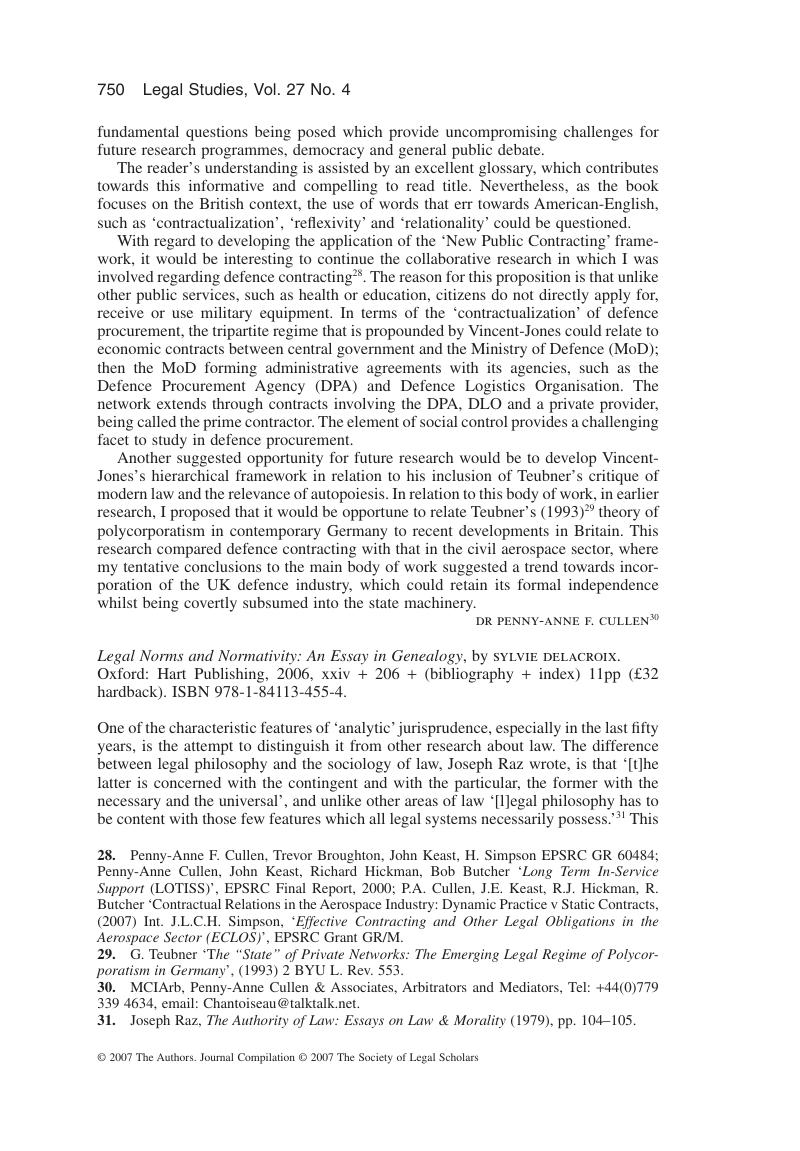No CrossRef data available.
Published online by Cambridge University Press: 02 January 2018

31. Joseph Raz, The Authority of Law: Essays on Law & Morality (1979), pp. 104–105.
32. S. Delacroix, Legal Norms and Normativity: An Essay in Genealogy, ix, 127.
33. Ibid, xvii.
34. Ibid, pp. 141–42, 148–52.
35. Friedrich Nietzsche, The Genealogy of Morals (1887) II §§4–8.
36. Alexander Nehamas, Nietzsche: Life as Literature (1985) 246 fn 1.
37. Delacroix, p. 97.
38. Ibid.
39. Delacroix also suggests that all three failed because of their ‘propensity to consider the normative dimension of law as a given… but never what conditions its possibility’ (p. 102). This is an odd claim: Delacroix herself says that ‘[b]y contrast [to Hart's account], Kelsen's theory does seek to understand what conditions the possibility of legal normativity’ (p. 69) and elsewhere says that the works of both Hart and Kelsen ‘are structured around the ambition to account for law's normativity’ (p. 83). Indeed the most famous aspect of Kelsen's theory, the hypothetical basic norm, is his suggested solution, one reached through an argument that purports to show that hypothesizing the basic norm is the only possible explanation of law's normativity. This does not seem like taking law's normativity as a given. As for whether Hart was at all interested in giving an account of the ‘conditions’ of law's normativity, I think this is a question on which his writings are ambiguous.
40. Ibid, p.102.
41. Ibid, p. 168. This is, strictly, Delacroix's take on Jules Coleman's ‘story’, but I think she would ascribe a similar error to quite a few other positivists. Compare, for example, her critique of Hart's explanation of normativity. Ibid, p. 114.
42. Ibid, p. 143.
43. Ibid, p. 205.
44. Ibid, p. 165.
45. Ibid, p. 107. Delacroix calls this view ‘moral realism’. But so defined, I doubt there is a single moral realist in the world.
46. Ibid, p. 188.
47. Ibid, p. 154, n. 54.
48. Ibid, xvii.
49. Friedrich Nietzsche, Beyond Good and Evil (1886) §§5, 6; Twilight of the Idols (1888) III §1. Nietzsche's work is replete with similar passages.
50. Delacroix, p. 128.
51. Ibid, p. 19.
52. For a brief suggestion that this is indeed the case see Allan Janik & Stephen Toulmin, Wittgenstein's Vienna (rev. ed., 1996) 133.
53. Delacroix, pp. 178–9. See also pp. 110, 135–136.
54. Delacroix traces this moment to the French Parliament's decision in 1593 to challenge the law that said that only Catholics could be kings. Ibid., pp. 135–36.
55. For a longer treatment see Danny Priel, ‘Forty Years On’ (unpublished manuscript).
56. Delacroix, p. 190.
57. For example, Ronald Dworkin, Justice in Robes (2006) 32.
58. Delacroix, pp. 199–200, 204.
59. Ibid, p. 204.
60. Dworkin, Justice in Robes, pp. 239–40, where Dworkin makes clear that he has little interest in the question of law's boundaries. See also Priel, ‘Forty Years On’, pp. 12–15.
61. Delacroix, p. 190.
62. Ibid, p. 121.